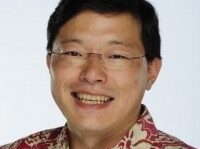Douglas Kiang is both a member of the EdTechTeacher instructional team as well as teaches computer science and heads the technology resource teachers group at Punahou School in Honolulu, Hawaii. He holds a Master's Degree in Technology, Innovation, and Education from Harvard and is an Apple Distinguished Educator. In addition to being an important thought-leader who addresses how technology reshapes our teaching, our classrooms, and learning spaces in general, he is the author of five bestselling game strategy guides and his latest book on Minecraft in Education is soon to be published by Peachpit Press.
What is the Classroom of the Future?
Douglas says that this is a funny concept to discuss, because by the time the future gets here, we won't be here to discuss it. In fact, if we sit long enough, the future will arrive; however, that doesn't mean that we have to change anything. However, what if our thoughts about the future help us to reexamine what we do in the present. To do this, Douglas is going to address three topics: Curriculum, Classrooms, and Community - where teachers are at the heart of the concept.
Curriculum
It's not so much what it is that you're teaching, but How Do You Learn Something New? For example, Douglas tells the story of his teenage son. He remembers his father teaching him how to share and then was looking forward to teaching his son. However, when the moment arrives, the son says, "I already know how to shave" because he had gone on YouTube. So while Douglas was disappointed about not having the opportunity to teach how to shave, he realized that he had taught his son how to be resourceful.
Similarly, one year, Douglas' daughter wanted to be Princess Zelda for Halloween. While the daughter had gone on Etsy to find a costume, she decided that she could make her own costume by going online and teaching herself. While his daughter isn't a "craftsy" person, when she felt a need, she was able to go find something.
DIY
Both of these stories are examples of how today's kids are part of a DIY Generation - they learn to go out and teach themselves. In fact, you can go to diy.org or download the app, and then kids can share projects that they have created with videos. Not only can kids teacher each other, but they can engage in conversation. Beyond the making, there's also an element of sharing.
Within DIY, there is a map for how to progress through a series of skills. Douglas says to consider it a roadmap to creativity. The focus is not on using technology or creating technology, but in thinking about creating and learning. After completing a challenge that would allow them to display their knowledge, they can earn badges. There's no order or designated path, so students can choose their own way to learn.
Make
DIY is a kid-friendly version of the adult site, Make. With makers, there's a credo that if you can't open it, then you don't own it. So Douglas asks, "How Open is Your Curriculum."
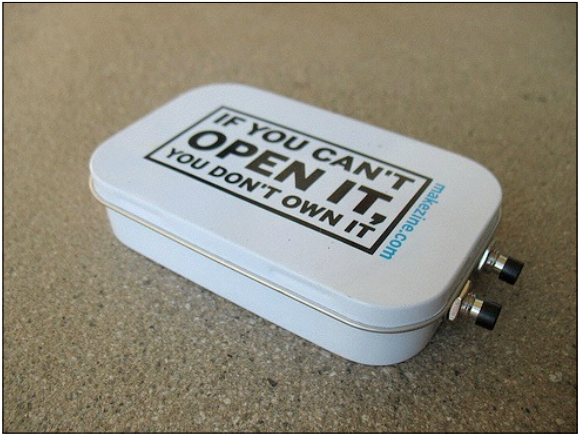
Douglas then tells the story not about a group that was lost in the Alps. They pulled out their map, made a plan, and eventually survived. When they got out of the mountains, they learned that the map was of the Pyrenees. So what do maps, or curriculum maps, give us?
- Comfort - something to serve as a foundation for our thinking
- Guidance - something to help provide a framework in order to get moving
Douglas transitioned from the idea of a curriculum to that of how it plays out in classrooms. As an AP Computer Science teacher, much of his curriculum was based on test prep. Unfortunately, this led to a lot of test taking and lecture, so he shifted to a Challenge Based Learning approach.
As a result of this, Douglas gave his class a challenge: design an app to solve a problem. To facilitate this, he decided to take lessons learned from working in a start up. Class time was like face to face meeting time. During those opportunities, Douglas wanted his students to collaborate and work together in order to work face to face - with the technology being used to extend the communications and do the work outside of class.
Another big shift that Douglas made was to use a Gantt Chart rather than a linear syllabus. With a design challenge, students needed to have multiple tasks running concurrently. This helped students understand that they don't have to wait for one task to be completed before beginning the next. They started to learn how to adapt and improvise.
What's the difference between a cook and a chef? - Marco Torres
Cooks vs Chefs
A cook follows a recipe while chefs create. Are we giving students directions and asking them to complete the tasks or are we empowering them to create? To design something that never existed before? As an example, Douglas shows the directions and suggestions from the breakfast bar at the Mariott. Because the bar includes lots of ingredients that could be used to create anything, they also provide a map to help guide people to create a new breakfast. Students need a map.
Douglas says that everyone has to start as a cook, but you train cooks and develop chefs. Just because a student can follow a recipe doesn't mean that they have learned everything that they need to know. How do we start to shift our classrooms in order to develop chefs?
App Design Challenges
One team created an app to solve the parking challenge at the Punahou Carnival. While it was great for the 2 days of the event, they were crestfallen when no one downloaded their app after it was over. They learned a valuable lesson to think about longer term problems.
A second group created an app to allow people to order from a restaurant and then have their food ready outside when they pulled up. Except for the fact that the restaurant served shaved ice. The group didn't listen to the needs of the customer, and didn't solve a true problem.
A third group designed an app to teach physical therapy exercises for a local office. They learned a tremendous amount about creating the content and working with the client. Another student created a counting app to help autistic students learn to count. Finally, a group created an app to help young children of divorce learn how to explain their feelings and interact with their parents. This app is now being used in schools all over. By working for the larger community and supporting people, students learned way more than coding - they learned about making connections.
While the App Design Challenge was a great opportunity for students to learn to code, Douglas still had to address the AP Exam. To do this, he created the challenge of everybody has to master the content. Suddenly, it became a community challenge rather than a single endeavor to become successful.
The students decided how they wanted to share their learning and then created online spaces that ranged from WikiSpaces and Reddit to Facebook. At the end of the year, Douglas usually gave a Computer Science award. Because of the community aspect of the course, he allowed the students to nominate each other for a number of awards. He learned a lot about his students through the nominations that he may not have otherwise learned.
Oranges vs Lemons - Context Makes a Difference
Douglas tells the story of a friend who bought a house and thought that they had the worst orange tree ever. However, they then discovered that it was actually a lemon tree. When framed with that in mind, the possibilities were endless! Douglas brings that back to the idea that we just need to think about our kids and our curriculum within a broader context.
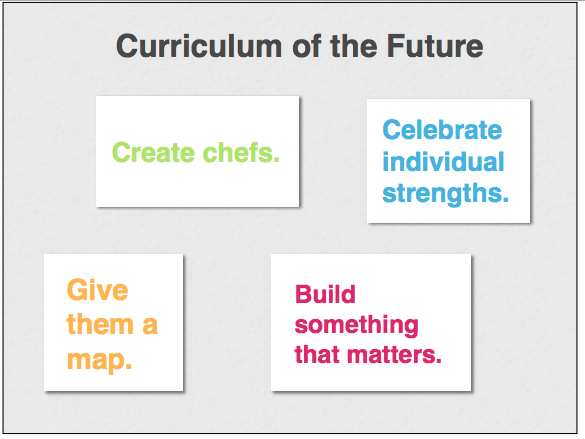
Classrooms
Douglas asked all of his students where they felt most creative. In all of the interviews, students spoke about the outdoors, the arts, and their homes. So it raises the question of where do we feel most creative and comfortable and how do we design our classrooms to support learning. Douglas shows that he feels most creative in a coffee shop, but he wasn't sure what made it that way.
The school of the future is a hybrid. Douglas says that it's about how we combine the physical and the digital to extend learning context. Even online classes have to create a presence and build relationships between kids. In many ways, every class is a hybrid environment if there's an online component. To learn more, Douglas visited a number of companies.
Google & Apple
Not only did the space provide opportunities for creation, but they also gave time for exploration. They provide food choices, but ones that are color coded by healthiness. You can still make choices, but it's informed choices. There are also lots of whimsical sculptures, art pieces, and even bikes around the place. Douglas asks, what happens when you start outside of the box.
Another big thing is that everyone in is a node for information and can be both a publisher and a consumer at all times with newsletters everywhere. Both Apple and Google have "genius bars" - informal spaces for collaboration, so how do we create these opportunities in our schools?
The Urban & Nueva Schools
Both of these schools take on many of the ideas from Google: open publishing, creative spaces, and an environment where students feel empowered to share. As a result, there's a sense of honor and respect because of the open environment.
Build Your Ideal Learning Commons
Punahou is in the process of redesigning some of their learning spaces that haven't been updated since the 70's. The design committee came up with a set of principles to guide the process.
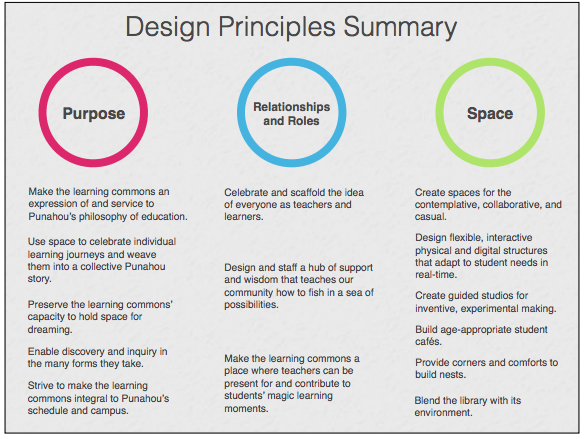
Douglas then put the challenge forward to his students:
Build your ideal "learning commons."
Think about what you are asked to do as a student. Then think about whatyou want to see in a physical space that supports what you do.
His students used Minecraft to create their prototypes. Each element that they designed had to tie back to the learning principles, but they could otherwise build anything that they could imagine. A few interesting things evolved:
- They put the art room in the library so that it could be closer to everything else.
- They wanted a maker space because they are being asked to create and invent more.
- They wanted a space to take a nap.
What's interesting is that Douglas could also see who built which aspect of the product - allowing him to look into the process as well as seeing the end product. In the end, they were able to quickly be creative and to design and publish.
Community
Douglas says that his definition includes all interactions - both online and face to face - as well as between students and with the teacher. Is your classroom a wheel or a web? Are you at the center or are your students able to build relationships? Master teachers can manage relationships in order to give kids the opportunities to collaborate as well as to negotiate their differences.
As a metaphor, Douglas says that if you really know each other, then you can figure out how to equally share an orange. What if one person wants just the peel and the other wants the juice? Then dividing the orange in half does not create an equitable division. This translates to how do we allow students to know each other in order to have shared value.
Challenge: create a self-sustaining community that reinforces trust among individuals and that rewards pro-social behavior. This is what drives Douglas' classroom.
Because Douglas has his students work in Minecraft all year, he asked them to create the rules of the community. It raised interesting questions:
- Should we be allowed to make mistakes?
- Should the environment be filtered?
The conversation was significantly more powerful than the coding, but they worked together to create their own rules to guide their community.
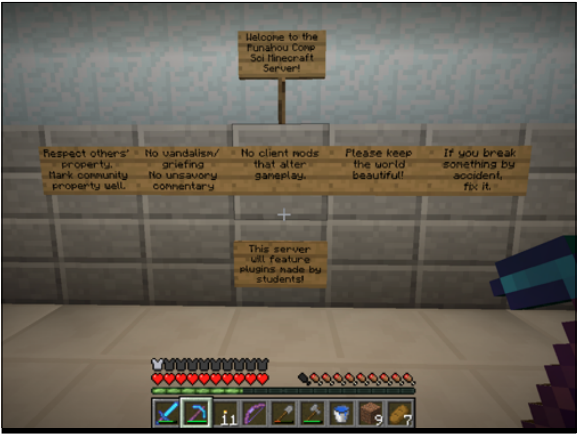
While Douglas allowed the students to run free, he also provided a to-do list so that his students have a map.
Should TNT Be Banned?
This became a discussion in class. Some students felt that it was too dangerous to have in the world. However, it sparked a massive debate about rights vs responsibility as well as addressing behavior vs materials. Essentially, it raised interesting conversations about what does it mean to have shared value, created a safe space for failure, and allowed kids to safely make mistakes.
The Story of the Stone Soup
Douglas closed by retelling the story of Stone Soup. His takeaway is that if the stranger doesn't come to town, then there's no soup. If you don't have someone to bring the stone, then the collaboration can't happen. Teachers are at the heart of the classroom of the future, because teachers are bringing the stone to facilitate collaboration. Our jobs as teachers are to understand students, to build relationships, and to provide the map to create change and create learning together. Teachers are the catalyst for change.
Douglas asks us to do 3 things: empower the individuals in our class to create a sense of community, provide a map to guide their learning, and know students so that shared value can be co-created.

